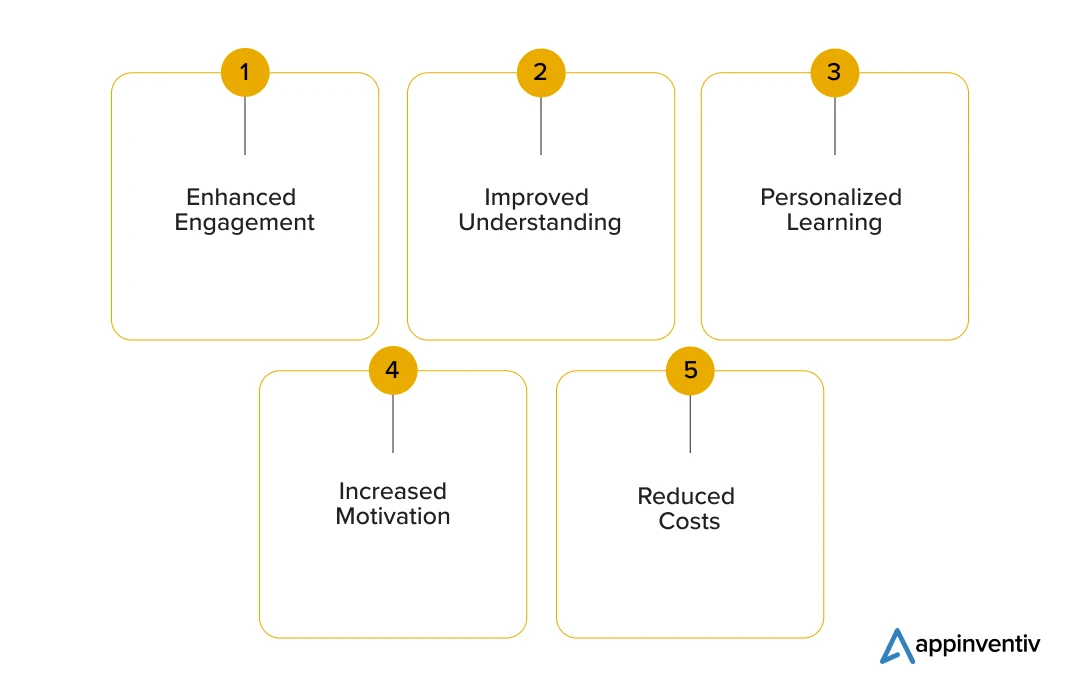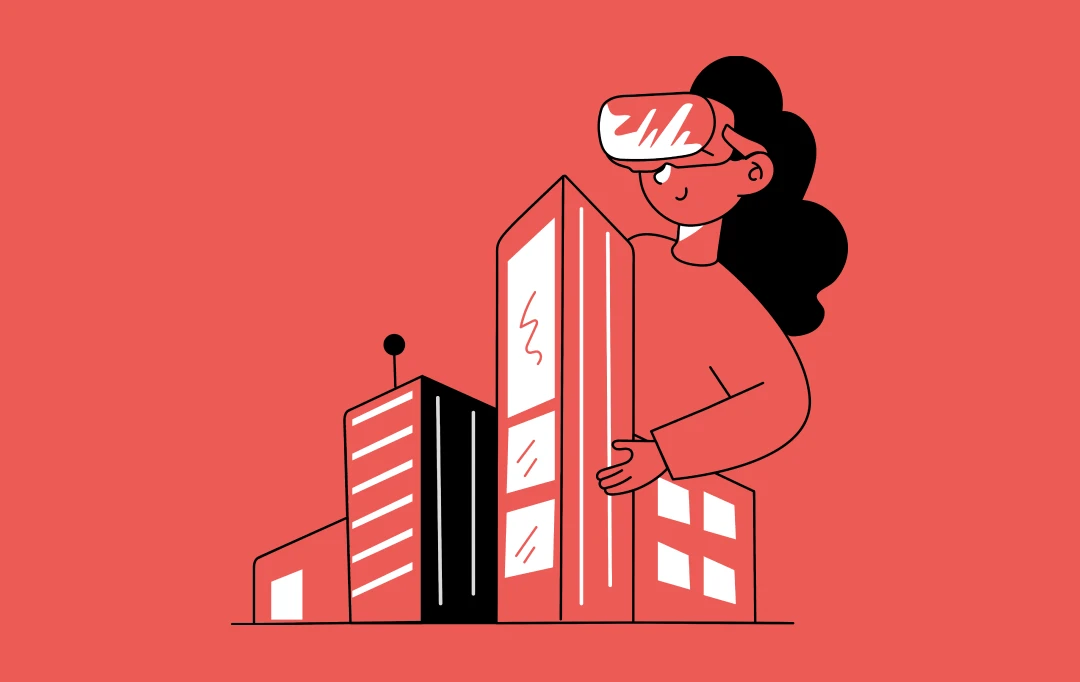- How Does Augmented Reality Impact Education?
- Education + Entertainment = Edutainment
- Top Three Types of AR in Education
- Marker-Based AR
- Markerless AR
- Superimposition-Based AR
- How Can Augmented Reality Be Used in Education?
- Augmented Classrooms
- Augmenting Homework
- Technical Education and Training
- Turn Abstract Concepts into Reality
- Simplified Conceptual Breakdown
- Uptick Student Engagement Rates
- Special Education for PwDs
- Augmented Reality for Content on Demand
- Immersive Classroom for Educators
- Real-World Examples of AR in Education
- CoSpaces Edu
- Google Translate
- QuiverVision
- ABC AR – Space Discovery
- Civilization AR
- How AR in Education Enhances Teaching and Learning Process
- Enhanced Engagement
- Improved Understanding
- Personalized Learning
- Increased Motivation
- Reduced Costs
- Challenges of Augmented Reality in Education
- Technical Challenges
- Lack of Content
- Resistance to Change
- Embrace AR in Education with Appinventiv
- FAQs
Today, the world is increasingly centered around Augmented Reality (AR), a technology that is redefining businesses across industries, including aviation, healthcare, real estate, eCommerce, and, most importantly, education.
AR significantly revolutionizes modern education systems by making learning more dynamic, interactive, and inclusive. How? As digitized learning initiatives reshape the landscape of K-12, college, and professional certifications, traditional classroom training is increasingly being supplemented by remote learning. It is where Augmented Reality steps in, addressing the gaps often found in basic “internet-enabled” education and remote learning.
What’s more? Augmented reality in education changes the way we teach and learn, adding a crucial layer of value to the teaching and learning patterns. Since each student processes information differently, a one-size-fits-all approach to teaching no longer suffices. By integrating digital content with the real world, AR in education creates interactive and personalized learning experiences that traditional methods cannot match.
Also, by addressing diverse learning styles within the same classroom, AR offers students a unique opportunity to understand intricate concepts more deeply, elevating the overall quality of education. The use of AR in classrooms is currently on the rise, but how are teachers using AR to engage and educate children? This blog discusses the deepening penetration of augmented reality in education and training by discovering its diverse applications in the education industry.
How Does Augmented Reality Impact Education?
There are strong reasons to state that AR in education is revolutionizing the industry. This supporting pillar of the Industrial Revolution 5.0 has grown exponentially in recent years, with the global AR market in education expected to be worth $14.2 billion by 2028, growing at a CAGR of 29.6% from 2023 to 2028.

Similar research by Statista forecasts that Augmented Reality will gain 1.7 billion users worldwide by the end of 2024, a significant rise of 1.5 billion from the 200 million witnessed in 2015. It is an incredible influx in numbers that highlights the rising importance of AR in various fields, including education, where it is giving rise to the concept of “Edutainment”—the fusion of education and entertainment.
Education + Entertainment = Edutainment
Visual learning toolkits catalyze student comprehension. Our brains process visuals 60,000 times faster than texts. Additionally, 90% of the information broadcasted to the brain by our senses is visual in nature. Surmising that we are creatures of habit, and our habits involve learning through watching, deploying Augmented Reality in education makes for an unfailing argument. Students would retain more of a lesson that involves immersive experiences than traditional teaching methods. This, in turn, pushes the accelerator to increase participation during classes.
Top Three Types of AR in Education
Augmented Reality in education encompasses various types, each offering unique ways to enhance learning experiences. Here are the three most common types of AR in education:

Marker-Based AR
Marker-based AR uses visual markers, such as QR codes or specific images, to trigger digital content when scanned with an AR-enabled device. In education, this can mean scanning a textbook image to reveal interactive 3D models or supplementary videos, enhancing understanding of complex concepts.
Markerless AR
Markerless AR doesn’t rely on visual markers but uses GPS, accelerometers, and other sensors to provide content based on the user’s location. In classrooms, this involves overlaying historical events onto physical locations within the school, making learning more contextually relevant.
Superimposition-Based AR
Superimposition-based AR overlays digital content onto real-world objects or scenes, allowing users to see enhancements or additional information about their surroundings. For example, students can point their devices at a solar system model and see detailed information about each planet or its orbits.

How Can Augmented Reality Be Used in Education?
The use cases of AR in education and training are vast and innovative, offering new ways to enhance learning experiences. Here are some of the most remarkable applications of AR in education that redefine traditional teaching and learning patterns:

Augmented Classrooms
AR can be seamlessly integrated into traditional classroom training through Marker-based AR apps. Students can scan their textbooks, following which the app will display visual illustrations of complex theoretical concepts. By experiencing these principles firsthand, the learning process becomes a fun and engaging extracurricular activity. AR has the potential to significantly enhance the quality of training in critical STEM (Science, Technology, Engineering, and Mathematics) subjects, making learning both more effective and enjoyable.
For instance, Octagon Studio is one startup that has leveraged the power of Augmented Reality for education. It uses AR-based flashcards to give students an illustrative and engaging learning experience in history, biology, and art.
Augmenting Homework
Who said homework has to be burdensome? Teachers could assign students AR-enabled worksheets to explore educational concepts at their own pace from the comfort of their couch. For instance, a given worksheet could contain a few questions on a particular topic. If the students are unable to crack the answer by themselves, they can scan the worksheet with the AR-based app and avail pointers for the right answer. Edtech startups should pick and choose a curriculum and align their AR app towards imbuing widely taught concepts to maximize their student user base.
ClassVR is one company making strides in the AR direction. Its augmented reality apps for education are tailored to English, Science, History, Design, and Technology.
Technical Education and Training
Acquiring practical skills in fields like agriscience, manufacturing, and engineering typically requires hands-on experiences that can be both risky and costly. Augmented reality education provides a safer and more cost-effective alternative, allowing learners to gain the necessary experience in a controlled, virtual environment. Through AR applications, students can practice assembling equipment, interact with complex machinery, and perform experiments in immersive 3D settings, all without the associated dangers of real-life scenarios.
Turn Abstract Concepts into Reality
Since AR uses 3D modeling and object recognition, it can transform challenging biological concepts into engaging anatomy lessons. With each student and future doctor interacting with virtual patients, the depth of learning increases significantly.
This experiment was tested at Portugal’s Polytechnic Institute of Leiria, where AR applications have proven to be as effective as their human counterpart teachers. The institution deployed AR apps that make biology lessons more accessible than traditional whiteboards and charts.
Simplified Conceptual Breakdown
STEM subjects, especially science often proves a challenge for trainers with its hard to explain concepts. For instance, a lecture on human anatomy that relies heavily on theoretics and a cardboard sample, may not invoke curiosity in all the students.
However, by integrating AR, students can explore these concepts through immersive 3D models and learn at their own pace. Also, AR applications empower teachers to create personalized content tailored to the needs and aptitudes of different student groups, making education more engaging and effective.

Uptick Student Engagement Rates
Classroom education represents just one aspect of AR in education management. Skilled mobile learning app developers can seamlessly integrate AR applications to elevate recreational activities, where simulated realities enhance the understanding of athletic movements and contribute to both mental and physical development by allowing students to engage with interactive content in a new way. This type of AR application not only captures students’ attention but also increases engagement, making the learning process more dynamic and effective.
Canadian Tech Company SAGA prototyped an AR-based Interactive Gym that uses this concept. Geometric projections are cast on gym walls under synthetic lighting, challenging toddlers to target and smash the shapes with rubber balls. SAGA’s computers use 3D camera vision to monitor the interplay of physical objects with the wall projections.
Special Education for PwDs
Augmented reality in learning is highly effective in enhancing experiences for students with disabilities. By creating immersive virtual environments that mimic real-life social interactions, AR allows these students to practice and learn in a safe, judgment-free space. This approach not only engages children of all ages but also empowers them to explore and experiment without the fear of negative consequences, making learning more accessible and impactful.
Augmented Reality for Content on Demand
As teachers and students adapt to Augmented Reality, the demand for on-demand content will grow. AR is poised to revolutionize how educational material is delivered by providing dynamic, interactive experiences tailored to individual needs.
With AR, educators and learners can access a vast array of content anytime, enhancing the learning experience. This shift towards content on demand highlights the growing need for Augmented Reality as a Service (ARaaS), which can offer scalable and customized educational solutions. By leveraging ARaaS, educational institutions can continuously update and expand their content offerings, ensuring that both teachers and students have access to the latest and most relevant learning materials.
Metaverse is an AR platform that exemplifies the power of content on demand in education. It enables users to create and customize virtual content based on their location, offering a dynamic way to engage with educational material. Teachers can use Metaverse to generate informational AR pop-ups instantly, providing on-the-spot explanations to clarify complex concepts.
Similarly, students can explore and test their hypotheses by running simulations directly through the app. This level of personalization ensures that educational content is not only relevant but also tailored to individual learning needs, significantly enhancing the overall learning experience.
Immersive Classroom for Educators
Using AR, aspiring teachers can hone their teaching strategies by engaging in realistic classroom simulations, particularly in challenging, high-pressure situations. These virtual interactions with simulated students allow educators to assess and improve their teaching techniques and classroom management skills in a risk-free environment, helping them prepare more effectively for real-world teaching experiences.
Also Read: How smart campuses are redefining the future of education – Benefits, use cases and technologies
Real-World Examples of AR in Education
Still unsure how AR and VR in education redefine the industry? Well, here are some real-world examples of augmented reality apps for education that unveil how this technology is reshaping teaching and learning experiences.

CoSpaces Edu
CoSpaces Edu allows students to build and animate their own 3D creations, which they can then explore in Augmented Reality. By projecting their virtual designs onto real-world surfaces and using the MERGE Cube, learners can interact with their creations in a hands-on way.
Google Translate
Google Translate uses location-based tracking and AR mode to instantly translate foreign text into English. This feature, also available as a Chrome extension, showcases AR’s potential in everyday applications, demonstrating its integration into mainstream technology.
QuiverVision
QuiverVision brings colors to life through 3D modeling, engaging young learners with interactive AR experiences. Available in three versions—Quiver, Quiver Education, and Quiver Fashion—this app has received widespread acclaim from educators, parents, and children alike, highlighting the role of AR in education.

ABC AR – Space Discovery
ABC AR Space Discovery captivates young minds with interactive 3D learning about space. This AR app inspires curiosity about the cosmos and introduces children to the wonders of space exploration in an engaging and educational manner.
Civilization AR
Civilization AR offers an immersive historical exploration experience for learners of all ages. Created in association with 30 museums, users can discover history like never before. From ancient Egypt to paintings and hidden treasure troves, Civilization AR packs a punch with its multi-device compatibility and high-resolution graphics, making learning about the past more interactive and engaging.
How AR in Education Enhances Teaching and Learning Process
AR in education offers numerous advantages to educators and students alike, enhancing both teaching and learning experiences. Here are some key benefits of augmented reality in education:

Enhanced Engagement
AR captivates students by providing interactive and immersive experiences that make learning more engaging and enjoyable. By overlaying digital content onto physical environments, AR transforms abstract concepts into tangible, visually stimulating lessons.
Improved Understanding
AR helps students grasp complex concepts easily by visualizing them in 3D. For instance, AR can turn a static diagram into an interactive model, allowing learners to explore the content from various angles, which aids in better comprehension and knowledge retention.

Personalized Learning
Augmented reality in learning offers personalized learning experiences by adapting content to individual needs. Students can learn at their own pace, revisit concepts as needed, and engage with material that suits their learning style.
Increased Motivation
The interactivity of AR can increase students’ motivation to learn. Gamified elements and interactive challenges make the learning process more enjoyable, encouraging active participation of students in the subject matter.
Reduced Costs
Compared to traditional educational tools, augmented reality education costs are often more budget-friendly. Typically, all that it requires is a smartphone with a camera and internet connection. It makes augmented reality education an accessible and cost-effective option for students.
You may like reading: AR App Development Cost – All You Need to Know
Challenges of Augmented Reality in Education
Implementing AR in education offers transformative benefits, but it also presents several challenges that educators and institutions must address to leverage its maximum advantages. Here are some key challenges along with their potential solutions to help you ease and elevate your AR initiatives:

Technical Challenges
Challenge: The integration of AR into educational settings often requires advanced hardware and software, such as AR-compatible devices and high-quality applications. This can pose a significant technical challenge, particularly for institutions with limited resources.
Solution: To address this, educational institutions can partner with a reputed AR development company to access affordable AR/VR app development services or leverage cloud-based AR platforms that reduce the need for high-end hardware.
Lack of Content
Challenge: AR’s effectiveness in education relies heavily on the availability of immersive, high-quality content tailored to specific subjects. Currently, there is a limited amount of such content, which can hinder its widespread adoption.
Solution: To overcome this, educators should invest significant time and effort in creating and or adapting AR content that aligns with curriculum standards.
Resistance to Change
Challenge: Resistance to adopting emerging technologies like AR or AI in education can be a significant barrier in the realm. Teachers and administrators may be hesitant to embrace the emerging trends of AR in education due to concerns about its efficacy or the disruption of traditional teaching methods.
Solution: To overcome resistance and foster its adoption among educators, institutions should demonstrate the benefits of augmented reality in education by running pilot programs, sharing impactful case studies, and presenting success stories.
Embrace AR in Education with Appinventiv
Augmented Reality in education is revolutionizing the industry by making learning more engaging, interactive, and accessible. Its ability to enhance understanding, personalize experiences, and increase engagement makes it a powerful tool in modern education systems, propelling institutions for AR adoption.
As educational institutions seek to integrate AR into their curricula, partnering with a proficient education app development company like Appinventiv can significantly streamline the process.
With our 9+ years of industry experience and proven track record of delivering 3000+ cutting-edge solutions, we are well-positioned to help educational institutions leverage the full potential of AR and other transformative technology.
For instance, we have partnered with leading educational organizations like Gurushala, Nova, and Bada Business to build innovative educational systems using advanced technologies such as Blockchain, AI, AR, and VR.
By collaborating with us, schools and universities can leverage innovative AR applications to enrich their teaching methods, drive student engagement, and, ultimately, elevate the quality of education. So, what are you waiting for? Embrace the future of learning with Appinventiv and unlock new possibilities for academic excellence.
Get in touch now.
FAQs
Q. What is AR in education?
A. Augmented reality for education refers to integrating digital content with the real world to create interactive and immersive learning experiences. It enhances understanding by overlaying 3D models, simulations, and other visual elements onto physical environments, making abstract concepts more tangible and engaging for students.
Q. How to use augmented reality in online classes?
A. In online classes, AR can transform learning by enhancing textbooks and worksheets with interactive 3D models, videos, and quizzes. Students can use AR-enabled devices to scan pages and access additional information or activities. Additionally, AR apps can create virtual field trips, simulations, and real-time feedback, making lessons more immersive and engaging.
Q. What are the emerging trends of AR in education?
A. Here are some of the emerging AR trends for education.
- Web-Based AR Solutions
- Mobile AR
- AI-Powered AR
- AR Integration with VR
- Collaborative AR
- Wearable AR
- AR-Enhanced Textbooks


- In just 2 mins you will get a response
- Your idea is 100% protected by our Non Disclosure Agreement.

10 Use Cases and Examples of How Extended Reality (XR) is Driving Innovation Across Industries
Imagine a factory where engineers diagnose machinery issues using 3D holograms or a hospital where surgeons rehearse complex procedures in a fully immersive virtual space before operating on a real patient. These scenarios are not distant possibilities - they are happening today and are powered by Extended Reality - XR use cases. As a convergence…

13 Use Cases and Examples of How Adaptive AI is Transforming Industries
Slashing downtime, boosting margins, automating workflow, and stealing your market share. You must be thinking that these buzzwords are Silicon Valley’s hype. No, these are the silent revolutions hitting Main Street industries. From manufacturing deploying demand forecasting to controlling production lines, healthcare tailoring predictive care and driving better outcomes. The success mantra—these industries are quietly…

AR/VR in Construction - 10 Use Cases of How Augmented and Virtual Reality is Shaping the Industry
The use of extended reality technologies is one of the growing trends in the expanding domain of construction technology. As the sector gradually adopts more sophisticated practices, virtual and augmented reality in construction have emerged as revolutionary solutions. With compelling advantages like planning, marketing, and training, AR/VR technologies are transforming the face of construction. Prescient…

















